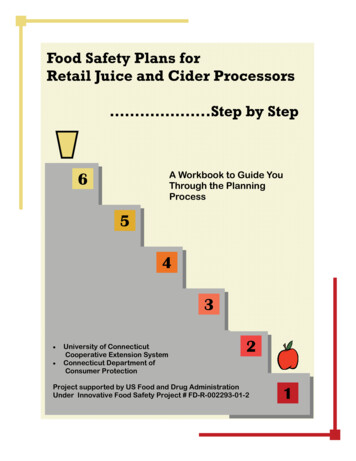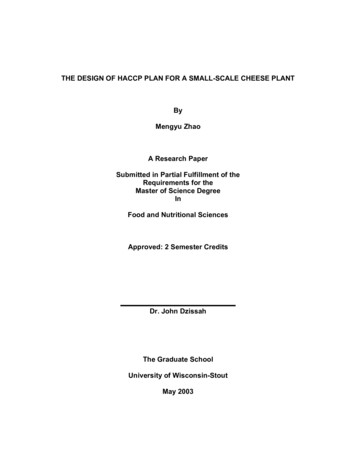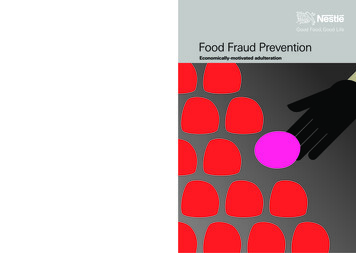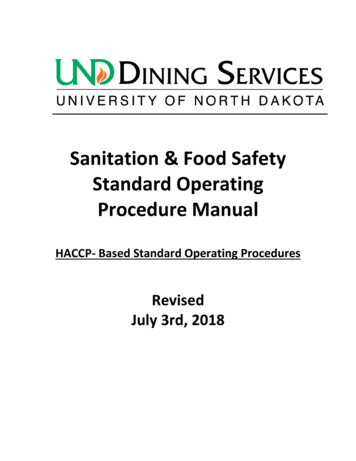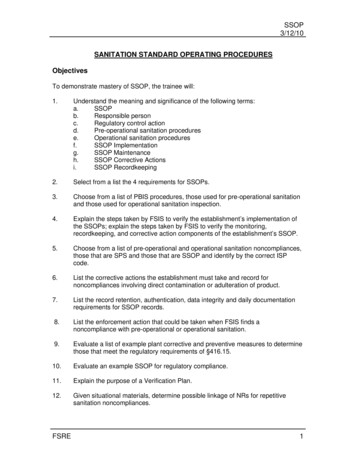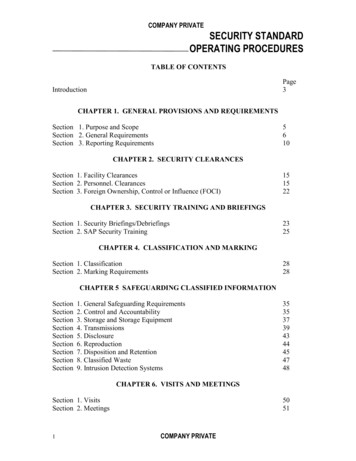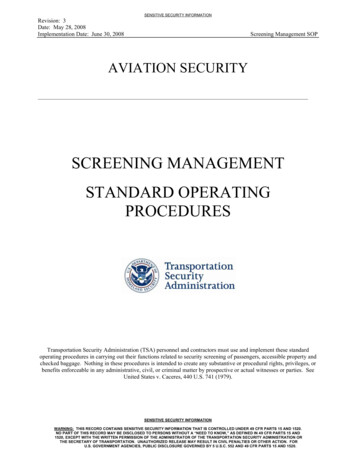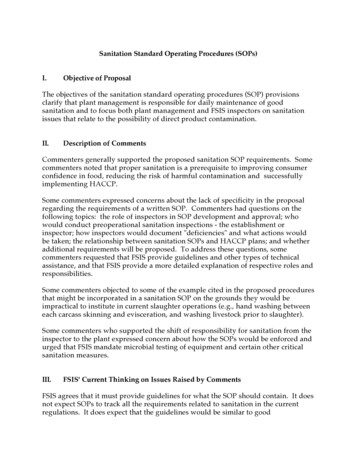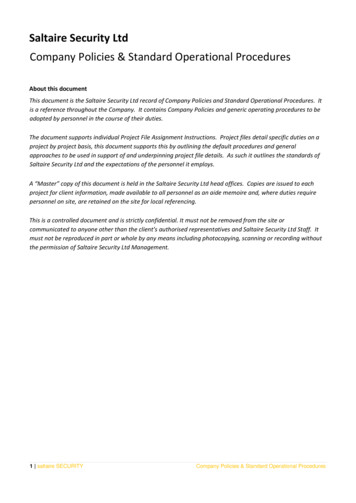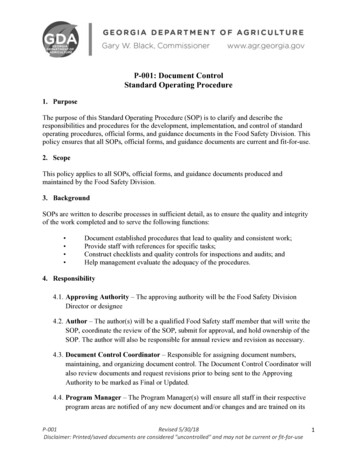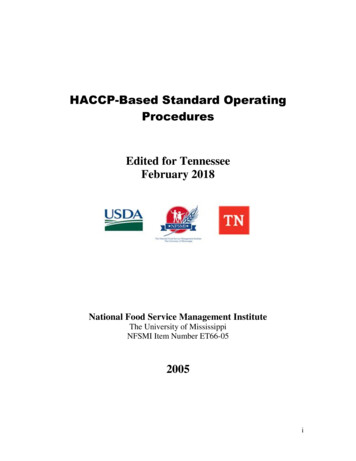
Transcription
HACCP-Based Standard OperatingProceduresEdited for TennesseeFebruary 2018National Food Service Management InstituteThe University of MississippiNFSMI Item Number ET66-052005i
HACCP- Based SOPsDisclaimersThis project has been funded at least in part with Federal funds from the U.S. Department of Agriculture,Food and Nutrition Service, through an agreement with the National Food Service Management Institute atThe University of Mississippi. The contents of this publication do not necessarily reflect the views orpolicies of the U.S. Department of Agriculture, nor does mention of trade names, commercial products, ororganizations imply endorsement by the U.S. government.The University of Mississippi is an EEO/Title VI/Title IX/Section 504/ADA/ADEA employer. 2005, National Food Service Management Institute, The University of Mississippi.Except as provided below, you may freely use the text and information contained in this document for nonprofit or educational use providing the following credit is included:Suggested Reference Citation:U.S. Department of Agriculture, Food and Nutrition Service, & National Food Service ManagementInstitute. (2005). HACCP-based standard operating procedures (SOPs). University, MS: Author.The photographs and images in this document may be owned by third parties and used by The Universityof Mississippi under a licensing agreement. The University cannot, therefore, grant permission to use theseimages. For more information, please contact nfsmi@olemiss.edu.ii
HACCP-Based SOPsNFSMI InformationNational Food Service Management InstituteThe University of MississippiBuilding the Future Through Child NutritionThe National Food Service Management Institute (NFSMI) was authorized by Congressin 1989 and established in 1990 at The University of Mississippi in Oxford. The Instituteoperates under a grant agreement with the United States Department of Agriculture, Foodand Nutrition Service.PURPOSEThe purpose of NFSMI is to improve the operation of Child Nutrition Programs throughresearch, education and training, and information dissemination. The AdministrativeOffices and Divisions of Technology Transfer and Education and Training are located inOxford. The Division of Applied Research is located at The University of SouthernMississippi in Hattiesburg.MISSIONThe mission of the NFSMI is to provide information and services that promote thecontinuous improvement of Child Nutrition Programs.VISIONThe vision of the NFSMI is to be the leader in providing education, research, andresources to promote excellence in Child Nutrition Programs.CONTACT INFORMATIONHeadquartersThe University of MississippiPhone: 800-321-3054Fax: 800-321-3061www.nfsmi.orgEducation and Training DivisionTechnology Transfer DivisionThe University of Mississippi6 Jeanette Phillips DriveP.O. Drawer 188University, MS 38677-0188Applied Research DivisionThe University of Southern Mississippi118 College Drive #10077Hattiesburg, MS 39406-0001Phone: 601-266-5773Fax: 888-262-9631iii
HACCP-Based SOPsAcknowledgmentsAcknowledgmentsWRITTEN AND DEVELOPED BYTheresa Stretch, MS, RD, CFSPGRAPHIC DESIGN BYVicki HoweEXECUTIVE DIRECTORCharlotte B. Oakley, PhD, RD, FADATASK FORCE MEMBERSStewart EidelStaff SpecialistMaryland Dept of EducationHolly McPeak,Public Affairs SpecialistUSDA, FSIS, Food Safety EducationJanice FabinaNutritionistUSDA/FNS Child Nutrition DivisionCindy RobertsJimmy LiuFood Safety Information SpecialistUSDA/FDA Food borne Illness EducationInformation CenterNational Agricultural LibraryEileen FerruggiaroNutritionistUSDA/FNS Child Nutrition DivisionMary Ann GabrielFood Service SupervisorDivision of Food and Nutrition ServicesMontgomery County Public SchoolsBeth KingNational Food Service Management InstituteUniversity of MississippiMary KlatkoAdministrator, Food & Nutrition ServiceHoward County Public School SystemPatrick A. TagueFood Service Field Operations ManagerCharles County Public SchoolsAlan M. TartRegional Retail Food SpecialistUS FDA, Southeast Regional OfficeDaren ZellerFood& Nutrition TechnicianHarford County Public SchoolsJody LydicArea AssistantBaltimore County Public SchoolGlenda R. LewisSupervisory Consumer Safety OfficerRetail Food Protection TeamCenter for Food Safety & Applied NutritionOffice of ComplianceUS FDAiv
HACCP-Based SOPsAcknowledgmentsREVIEWERSSincere appreciation is expressed to the representatives from the United StatesDepartment of Agriculture and United States Food and Drug Administrators whocontributed their time and expertise to review these materials. Special thanks to AlanTart for his commitment in the development of this project.PILOT TESTWe are grateful to the State agencies, state school nutrition associations, and the schoolnutrition professionals in the 29 states who participated in the pilot test.v
HACCP-Based SOPsTable of ContentsTable of ContentsIntroduction HACCP-Based Standard Operating Procedures Cleaning and Sanitizing Food Contact Surfaces . . Controlling Time and Temperature During Preparation Cooking Potentially Hazardous Foods . Cooling Potentially Hazardous Foods Date Marking and Ready-to-Eat, Potentially Hazardous Food . Handling a Food Recall . Holding Hot and Cold Potentially Hazardous Foods . Personal Hygiene Preventing Contamination at Food Bars Preventing Cross-Contamination During Storage and Preparation Receiving Deliveries . Reheating Potentially Hazardous Foods Serving Food . Storing and Using Poisonous or Toxic Chemicals . Transporting Food to Remote Sites (Satellite Kitchens) Using and Calibrating Thermometers Using Suitable Utensils When Handling Ready-to-Eat Foods . Using Time Alone as a Public Health Control to Limit BacteriaGrowth in Potentially Hazardous Foods . . Washing Fruits and Vegetables . Washing Hands .HACCP-Based Standard Operating Procedures Record Keeping . Cooking and Reheating Temperature Log . Cooling Temperature Log . Damaged or Discarded Product Log . Food Contact Surfaces Cleaning and Sanitizing Log . Production Log . Receiving Log Refrigeration Log . Thermometer Calibration Log Food Safety Checklist 57585960vi
HACCP-Based SOPsTable of ContentsDeveloping a HACCP-Based Food Safety Program Worksheets . Components of a Comprehensive Food Safety Program . . Summary Table of Record Keeping for HACCP-Based SOP . . Summary Table for Monitoring and Verifying HACCP-BasedSOP Record Summary of Corrective Actions for HACCP-Based SOPs . . Employee Food Safety Training Record No-Cook Process Same Day Service Process . Complex Food Process .64676871Reference List . . Resource List . .88897581828486vii
HACCP-Based SOPsIntroductionBackgroundThe U.S. Department of Agriculture (USDA) has issued guidance for the implementation of Hazard Analysis and Critical ControlPoint (HACCP) -based food safety programs in schools participating in the National School Lunch Program (NSLP) or the SchoolBreakfast Program (SBP). Section 111 of the Child Nutrition and WIC Reauthorization Act of 2004 (Public Law 108-265) amendedsection 9(h) of the Richard B. Russell National School Lunch Act by requiring school food authorities (SFAs) to implement a foodsafety program for the preparation and service of school meals served to children. The requirement is effective in the school yearbeginning July 1, 2005. The food safety program must be based on HACCP principles as outlined in the guidance.All SFAs must have a fully implemented food safety program that complies with HACCP principles or with the optional guidance nolater than the end of the 2005–2006 school year. For information specific to the implementation of the guidance in your state, contactyour State Agency.HACCP-Based Standard Operating Procedures (SOPs)The National Food Service Management Institute (NFSMI) has developed HACCP-based Standard Operating Procedures inconjunction with USDA and FDA. Although the NFSMI SOPs include HACCP-based principles, you should remember that SOPs areonly one component of your overall food safety program.This resource provides sample HACCP-based Standard Operating Procedures (SOPs) and worksheets which contain the minimumelements that can assist you when developing your food safety program. Print the HACCP-based SOPs and complete the worksheetswhich have been included in this resource and you will see a model for developing your food safety program.HACCP-based SOPs include the following principles: Corrective actions Monitoring procedures Verification procedures Record keeping proceduresYour food safety program should be specific to meet the needs of each food production and food service facility in your district. Youmay need to modify the SOPs and worksheets so they comply with your State and local requirements. Additional information thatwill assist you in the development of your food safety program is forthcoming and will be placed on the NFSMI Web site at:www.nfsmi.org .1
HACCP-Based SOPsIntroductionAdapted from: United States Department of Agriculture, Food and Nutrition Service. (June 2005). Guidance for School Food Authorities: Developing a SchoolFood Service Program Based on the Process Approach to HACCP Principles. United States Department of Agriculture, Food and Nutrition Service. ble/HACCPGuidance.pdf2
HACCP-Based SOPsCleaning and Sanitizing Food Contact Surfaces(Sample SOP)PURPOSE: To prevent foodborne illness by ensuring that all food contact surfaces are properly cleaned and sanitized.SCOPE: This procedure applies to employees involved in cleaning and sanitizing food contact surfaces.KEY WORDS: Food Contact Surface, Cleaning, SanitizingINSTRUCTIONS:1. Train employees on using the procedures in this SOP.2. Follow State or local health department requirements.3. Follow manufacturer’s instructions regarding the use and maintenance of equipment and use of chemicals for cleaning andsanitizing food contact surfaces. Refer to Storing and Using Poisonous or Toxic Chemicals SOP.4. State or local requirements are based on the 2009 FDA Food Code, wash, rinse, and sanitize food contact surfaces of sinks, tables,equipment, utensils, thermometers, carts, and equipment: Before each use Between uses when preparing different types of raw animal foods, such as eggs, fish, meat, and poultry Between uses when preparing ready-to-eat foods and raw animal foods, such as eggs, fish, meat, and poultry Any time contamination occurs or is suspected5. Wash, rinse, and sanitize food contact surfaces of sinks, tables, equipment, utensils, thermometers, carts, and equipment using thefollowing procedure: Wash surface with detergent solution. Rinse surface with clean water. Sanitize surface using a sanitizing solution mixed at a concentration specified on the manufacturer’s label. Place wet items in a manner to allow air drying.3
HACCP-Based SOPsCleaning and Sanitizing Food Contact Surfaces, continued(Sample SOP)INSTRUCTIONS, continued:6. If a 3-compartment sink is used, setup and use the sink in the following manner: In the first compartment, wash with a clean detergent solution at or above 110 oF or at the temperature specified by thedetergent manufacturer. In the second compartment, rinse with clean water. In the third compartment, sanitize with a sanitizing solution mixed at a concentration specified on the manufacturer’s label orby immersing in hot water at or above 171 oF for 30 seconds. Test the chemical sanitizer concentration by using anappropriate test kit.7. If a dishmachine is used: Check with the dishmachine manufacturer to verify that the information on the data plate is correct. Refer to the information on the data plate for determining wash, rinse, and sanitization (final) rinse temperatures; sanitizingsolution concentrations; and water pressures, if applicable. Follow manufacturer’s instructions for use. Ensure that food contact surfaces reach a surface temperature of 160 oF or above if using hot water to sanitize.MONITORING:Employees will:1. During all hours of operation, visually and physically inspect food contact surfaces of equipment and utensils to ensure that thesurfaces are clean.2. In a 3-compartment sink, on a daily basis: Visually monitor that the water in each compartment is clean. Take the water temperature in the first compartment of the sink by using a calibrated thermometer. If using chemicals to sanitize, test the sanitizer concentration by using the appropriate test kit for the chemical. If using hot water to sanitize, use a calibrated thermometer to measure the water temperature. Refer to Using and CalibratingThermometers SOPs.4
HACCP-Based SOPsCleaning and Sanitizing Food Contact Surfaces, continued (Sample SOP)MONITORING, continued:3. In a dishmachine, on a daily basis: Visually monitor that the water and the interior parts of the machine are clean and free of debris. Continually monitor the temperature and pressure gauges, if applicable, to ensure that the machine is operating according tothe data plate. For hot water sanitizing dishmachine, ensure that food contact surfaces are reaching the appropriate temperature by placing apiece of heat sensitive tape on a smallware item or a maximum registering thermometer on a rack and running the item or rackthrough the dishmachine. For chemical sanitizing dishmachine, check the sanitizer concentration on a recently washed food-contact surface using anappropriate test kit.CORRECTIVE ACTION:1. Retrain any employee found not following the procedures in this SOP.2. Wash, rinse, and sanitize dirty food contact surfaces. Sanitize food contact surfaces if it is discovered that the surfaces were notproperly sanitized. Discard food that comes in contact with food contact surfaces that have not been sanitized properly.3. In a 3-compartment sink: Drain and refill compartments periodically and as needed to keep the water clean. Adjust the water temperature by adding hot water until the desired temperature is reached. Add more sanitizer or water, as appropriate, until the proper concentration is achieved.4. In a dishmachine: Drain and refill the machine periodically and as needed to keep the water clean. Contact the appropriate individual(s) to have the machine repaired if the machine is not reaching the proper wash temperatureindicated on the data plate. For a hot water sanitizing dishmachine, retest by running the machine again. If the appropriate surface temperature is still notachieved on the second run, contact the appropriate individual(s) to have the machine repaired. Wash, rinse, and sanitize in the3-compartment sink until the machine is repaired or use disposable single service/single-use items if a 3-compartment sink isnot available. For a chemical sanitizing dishmachine, check the level of sanitizer remaining in bulk container. Fill, if needed. “Prime” themachine according to the manufacturer’s instructions to ensure that the sanitizer is being pumped through the machine.5
HACCP-Based SOPsCleaning and Sanitizing Food Contact Surfaces, continued (Sample SOP)CORRECTIVE ACTION, continued:Retest. If the proper sanitizer concentration level is not achieved, stop using the machine and contact the appropriate individual(s)to have it repaired. Use a 3-compartment sink to wash, rinse, and sanitize until the machine is repaired.VERIFICATION AND RECORD KEEPING:Employees will record monitoring activities and any corrective action taken on the Food Contact Surfaces Cleaning and SanitizingLog. The manager will verify that employees have taken the required temperatures and tested the sanitizer concentration by visuallymonitoring employees during the shift and reviewing, initialing, and dating the Food Contact Surfaces Cleaning and Sanitizing Log.The log will be kept on file for at least 1 year. The manager will complete the Food Safety Checklist daily. The Food SafetyChecklist is to be kept on file for a minimum of 1 year.DATE IMPLEMENTED: BY:DATE REVIEWED: BY:DATE REVISED: BY:6
HACCP-Based SOPsControlling Time and Temperature During Preparation(Sample SOP)PURPOSE: To prevent foodborne illness by limiting the amount of time that potentially hazardous foods are held in the temperaturedanger zone during preparation.SCOPE: This procedure applies to employees who prepare food.KEY WORDS: Cross-Contamination, Time and Temperature Control, Food Preparation, Temperature Danger ZoneINSTRUCTIONS:1. Train employees on using the procedures in this SOP. Refer to the Using and Calibrating Thermometers SOP.2. Follow State or local health department requirements.3. Wash hands prior to preparing foods. Refer to the Washing Hands SOP.4. Use clean and sanitized equipment and utensils while preparing food.5. Separate raw foods from ready-to-eat foods by keeping them in separate containers until ready to use and by using separatedispensing utensils. Refer to the Preventing Cross-Contamination During Storage and Preparation SOP.6. Pre-chill ingredients for cold foods, such as sandwiches, salads, and cut melons, to41 ºF or below before combining with other ingredients.7. Prepare foods as close to serving times as the menu will allow.8. Prepare food in small batches.9. Limit the time for preparation of any batches of food so that ingredients are not at room temperature for more than 30 minutesbefore cooking, serving, or being returned to the refrigerator.10. If potentially hazardous foods are not cooked or served immediately after preparation, quickly chill. Refer to the CoolingPotentially Hazardous Foods SOP and Date Marking SOP.7
MONITORING:1. Use a clean, sanitized, and calibrated probe thermometer, preferably a thermocouple.2. Take at least two internal temperatures from each pan of food at various stages of preparation.3. Monitor the amount of time that food is in the temperature danger zone. It should not exceed 4 hours.HACCP-Based SOPsControlling Time and Temperature During Preparation, continued(Sample SOP)CORRECTIVE ACTIONS:1. Retrain any employee found not following the procedures in this SOP.2. Begin the cooking process immediately after preparation is complete for any foods that will be served hot.3. Rapidly cool ready-to-eat foods or foods that will be cooked at a later time.4. Immediately return ingredients to the refrigerator if the anticipated preparation completion time is expected to exceed 30 minutes.5. Discard food held in the temperature danger zone for more than 4 hours.VERIFICATION AND RECORD KEEPING:Employees will record the date, product name, start and end times of production, the two temperature measurements taken, anycorrective actions taken, and the amount of food prepared on the Production Log. The manager will verify that employees are takingthe required temperatures and following the proper preparation procedure by visually monitoring employees during the shift andreviewing, initialing, and dating the Production Log daily. Maintain the Production Log as directed by your State agency. Themanager will complete the Food Safety Checklist daily. The Food Safety Checklist is to be kept on file for a minimum of 1 year.DATE IMPLEMENTED: BY:DATE REVIEWED: BY:DATE REVISED: BY:8
HACCP-Based SOPsCooking Potentially Hazardous Foods(Sample SOP)PURPOSE: To prevent foodborne illness by ensuring that all foods are cooked to the appropriate internal temperature.SCOPE: This procedure applies to employees who prepare or serve food.KEY WORDS: Cross-Contamination, Temperatures, CookingINSTRUCTIONS:1. Train employees on using the procedures in this SOP. Refer to the Using and Calibrating Thermometers SOP.2. Follow State or local health department requirements.3. If a recipe contains a combination of meat products, cook the product to the highest required temperature.4. If State or local health department requirements are based on the 2009 FDA Food Code, cook products to the followingtemperatures:a. 145 ºF for 15 seconds Seafood, beef, and pork Eggs cooked to order that are placed onto a plate and immediately servedb. 155 ºF for 15 seconds Ground products containing beef, pork, or fish Fish nuggets or sticks Eggs held on a steam table Cubed or Salisbury steaksc. 165 ºF for 15 seconds Poultry Stuffed fish, pork, or beef Pasta stuffed with eggs, fish, pork, or beef (such as lasagna or manicotti)d. 140 ºF for 15 seconds Fresh, frozen, or canned fruits and vegetables that are going to be held on a steam table or in a hot box9
HACCP-Based SOPsCooking Potentially Hazardous Foods, continued(Sample SOP)MONITORING:1. Use a clean, sanitized, and calibrated probe thermometer, preferably a thermocouple.2. Avoid inserting the thermometer into pockets of fat or near bones when taking internal cooking temperatures.3. Take at least two internal temperatures from each batch of food by inserting the thermometer into the thickest part of the productwhich usually is in the center.4. Take at least two internal temperatures of each large food item, such as a turkey, to ensure that all parts of the product reach therequired cooking temperature.CORRECTIVE ACTION:1. Retrain any employee found not following the procedures in this SOP.2. Continue cooking food until the internal temperature reaches the required temperature.VERIFICATION AND RECORD KEEPING:Employees will record product name, time, the two temperatures/times, and any corrective action taken on the Cooking and ReheatingTemperature Log.manager will verify that employees has taken the required cooking temperatures by visually monitoring employees and preparationprocedures during the shift and reviewing, initialing, and dating the temperature log at the close of each day. The Cooking andReheating Temperature Log is to be kept on file for a minimum of 1 year.DATE IMPLEMENTED: BY:DATE REVIEWED: BY:DATE REVISED: BY:10
HACCP-Based SOPsCooling Potentially Hazardous Foods(Sample SOP)PURPOSE: To prevent foodborne illness by ensuring that all potentially hazardous foods are cooled properly.SCOPE: This procedure applies to employees who prepare or serve food.KEY WORDS: Cross-Contamination, Temperatures, Cooling, HoldingINSTRUCTIONS:1. Train employees on using the procedures in this SOP. Refer to the Using and Calibrating Thermometers SOP.2. Follow State or local health department requirements.3. Modify menus, production schedules, and staff work hours to allow for implementation of proper cooling procedures.4. Prepare and cool food in small batches.5. Chill food rapidly using an appropriate cooling method: Place food in shallow containers no more than 4 inches deep and uncovered on the top shelf in the back of the walk-in orreach-in cooler. Use a quick-chill unit such as a blast chiller. Stir the food in a container placed in an ice water bath. Add ice as an ingredient. Separate food into smaller or thinner portions. Pre-chill ingredients and containers used for making bulk items such as salads.6. If State or local requirements are based on the 2009 FDA Food Code, chill cooked, hot food from: 140 ºF to 70 ºF within 2 hours. Take corrective action immediately if food is not chilled from 140 ºF to 70 ºF within 2 hours. 70 ºF to 41 ºF or below in remaining time. The total cooling process from 140 ºF to 41 ºF may not exceed 6 hours. Takecorrective action immediately if food is not chilled from 140 ºF to 41 ºF within the 6 hour cooling process.7. Chill prepared, ready-to-eat foods such as tuna salad and cut melons from 70 ºF to 41 ºF or below within 4 hours. Take correctiveaction immediately if ready-to-eat food is not chilled from 70 ºF to 41 ºF within 4 hours.11
HACCP-Based SOPsCooling Potentially Hazardous Foods, continued (Sample SOP)MONITORING:1. Use a clean, sanitized, and calibrated probe thermometer to measure the internal temperature of the food during the coolingprocess.2. Monitor temperatures of products every hour throughout the cooling process by inserting a probe thermometer into the center ofthe food and at various locations in the product.CORRECTIVE ACTION:1. Retrain any employee found not following the procedures in this SOP.2. Reheat cooked, hot food to 165 ºF for 15 seconds and start the cooling process again using a different cooling method when thefood is: Above 70 ºF and 2 hours or less into the cooling process; and Above 41 ºF and 6 hours or less into the cooling process.3. Discard cooked, hot food immediately when the food is: Above 70 ºF and more than 2 hours into the cooling process; or Above 41 ºF and more than 6 hours into the cooling process.3. Use a different cooling method for prepared ready-to-eat foods when the food is above 41 ºF and less than 4 hours into the coolingprocess.4. Discard prepared ready-to-eat foods when the food is above 41 ºF and more than 4 hours into the cooling process.VERIFICATION AND RECORD KEEPING:Employees will record temperatures and corrective actions taken on the Cooling Temperature Log. Employees will record if there areno foods cooled on any working day by indicating “No Foods Cooled” on the Cooling Temperature Log. The manager will verify thatemployees are cooling food properly by visually monitoring employees during the shift and reviewing, initialing, and dating thetemperature log each working day. The Cooling Temperature Logs are to be kept on file for a minimum of 1 year.DATE IMPLEMENTED: BY:DATE REVIEWED: BY:DATE REVISED: BY:12
HACCP-Based SOPsDate Marking Ready-to-Eat, Potentially Hazardous Food(Sample SOP)PURPOSE: To ensure appropriate rotation of ready-to-eat food to prevent or reduce foodborne illness from Listeria monocytogenes.SCOPE: This procedure applies to employees who prepare, store, or serve food.KEY WORDS: Ready-to-Eat Food, Potentially Hazardous Food, Date Marking, Cross-ContaminationINSTRUCTIONS:1. Train employees on using the procedures in this SOP. The best practice for a date marking system would be to include a labelwith the product name, the day or date, and time it is prepared or opened. Examples of how to indicate when the food is preparedor opened include: Labeling food with a calendar date, such as “cut cantaloupe, 5/26/05, 8:00 a.m.,” Identifying the day of the week, such as “cut cantaloupe, Monday, 8:00 a.m.,” or Using color-coded marks or tags, such as cut cantaloupe, blue dot, 8:00 a.m. means “cut on Monday at 8:00 a.m.”2. Follow State or local health department requirements.3. Label ready-to-eat, potentially hazardous foods that are prepared on-site and held for more than 24 hours.4. Label any processed, ready-to-eat, potentially hazardous foods when opened, if they are to be held for more than 24 hours.5. Refrigerate all ready-to-eat, potentially hazardous foods at 41 ºF or below.6. Serve or discard refrigerated, ready-to-eat, potentially hazardous foods within 7 days.7. Indicate with a separate label the date prepared, the date frozen, and the date thawed of any refrigerated, ready-to-eat, potentiallyhazardous foods.8. Calculate the 7-day time period by counting only the days that the food is under refrigeration. For example: On Monday, 8/1/05, lasagna is cooked, properly cooled, and refrigerated with a label that reads, “Lasagna, Cooked, 8/1/05.” On Tuesday, 8/2/05, the lasagna is frozen with a second label that reads, “Frozen, 8/2/05.” Two labels now appear on thelasagna. Since the lasagna was held under refrigeration from Monday, 8/1/05 – Tuesday, 8/2/05, only 1 day is counted towardsthe 7-day time period.13
INSTRUCTIONS, continued: On Tuesday 8/16/05 the lasagna is pulled out of the freezer. A third label is placed on the lasagna that reads, “Thawed,8/16/05.” All three labels now appear on the lasagna. The lasagna must be served or discarded within 6 days.MONITORING:A designated employee will check refrigerators daily to verify that foods are date marked and that foods exceeding the 7-day timeperiod are not being used or stored.CORRECTIVE ACTION:1. Retrain any employee found not following the procedures in this SOP.2. Foods that are not date marked or that exceed the 7-day time period will be discarded.VERIFICATION AND RECORD KEEPING:The manager will complete the Food Safety Checklist daily. The Food Safety Checklist is to be kept on file for a minimum of 1 year.DATE IMPLEMENTED: BY:DATE REVIEWED: BY:DATE REVISED: BY:14
HACCP-Based SOPsHandling a Food Recall(Sample SOP)PURPOSE: To prevent foodborne illness in the event of a product recall.SCOPE: This procedure applies to employees who prepare or serve food.KEY WORDS: Food RecallsINSTRUCTIONS:1. Train employees on using the procedures in this SOP.2. Follow State or local health department requirements.3. Review the food recall notice and specific instructions that have been identified in the notice.4. Communicate the food recall notice to feeding sites.5. Hold the recalled product using the following steps: Physically segregate the product, including any open containers, leftover product, and food items in current production
HACCP-Based SOPs Introduction Adapted from: United States Department of Agriculture, Food and Nutrition Service. (June 2005). Guidance for School Food Authorities: Developing a School Food Service Program Based on the Process Approach to HACCP Principles. United States Department of Agricult
